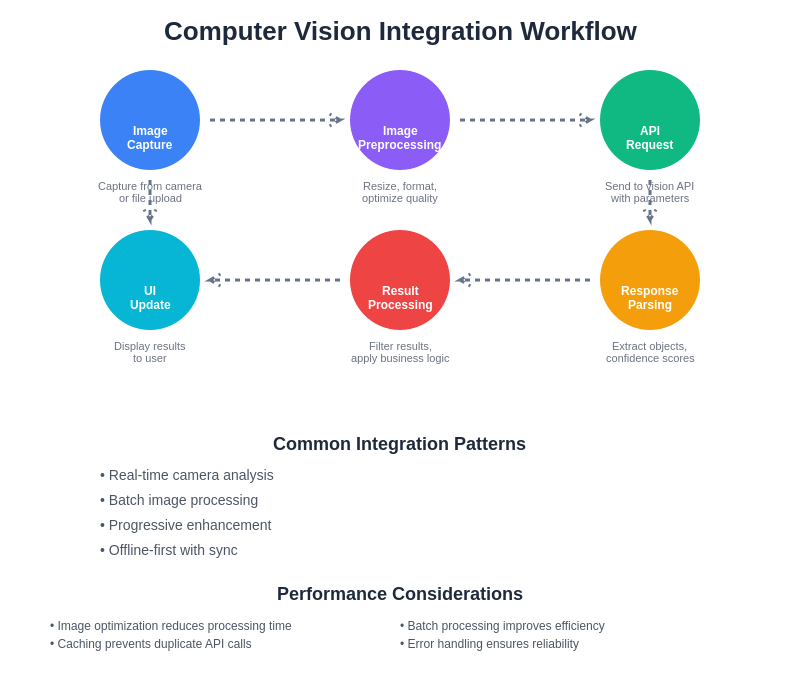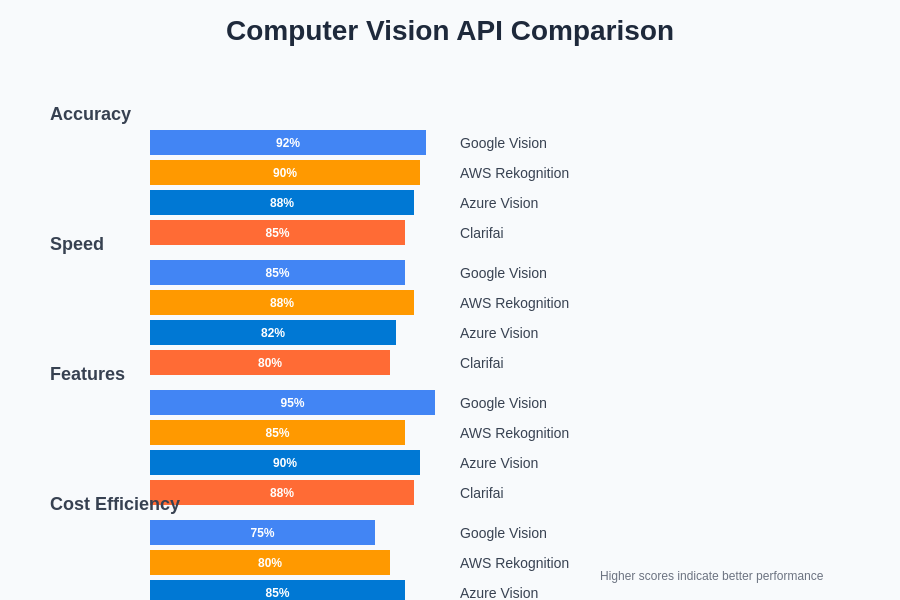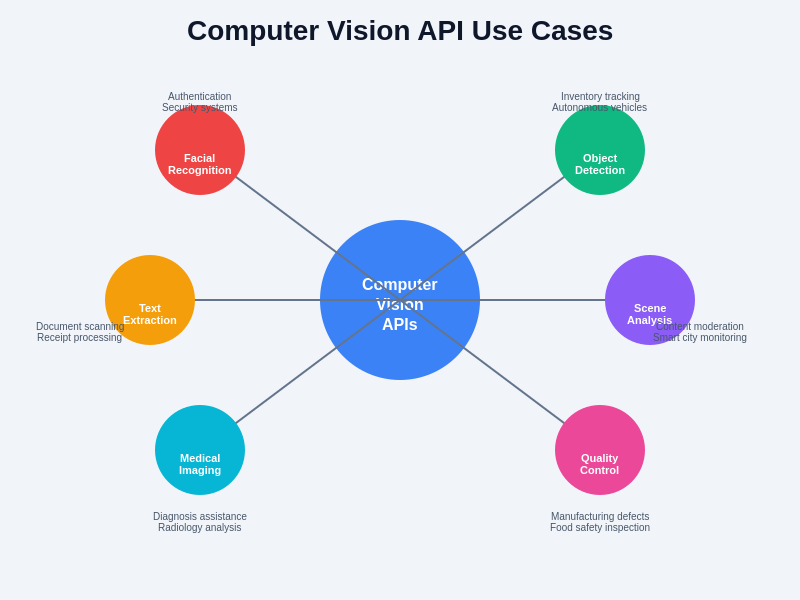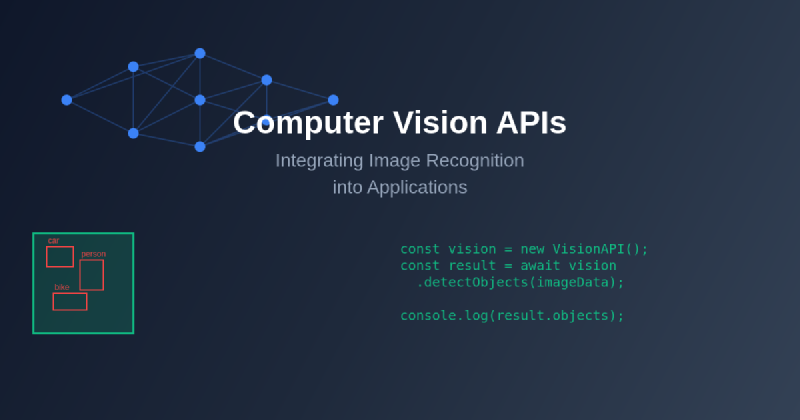The integration of computer vision capabilities into modern applications has transformed from a highly specialized domain requiring extensive machine learning expertise into an accessible technology that developers can implement through powerful APIs. Computer vision APIs have democratized advanced image recognition, object detection, facial analysis, and scene understanding capabilities, enabling developers to create sophisticated applications that can perceive and interpret visual information with remarkable accuracy and efficiency.
Explore the latest AI developments in computer vision to stay updated on cutting-edge technologies that are reshaping how applications interact with visual data. The evolution of computer vision APIs represents a fundamental shift in application development, where complex visual intelligence can be integrated seamlessly into any software solution without requiring deep expertise in machine learning algorithms or neural network architectures.
Understanding Computer Vision API Fundamentals
Computer vision APIs provide pre-trained machine learning models that can analyze and interpret visual content through simple HTTP requests or SDK integrations. These services abstract the complexity of neural network architectures, training processes, and computational infrastructure, allowing developers to focus on building innovative user experiences rather than implementing computer vision algorithms from scratch. The underlying technology leverages deep learning models trained on massive datasets containing millions of labeled images, enabling these APIs to recognize objects, faces, text, scenes, and patterns with human-level or superior accuracy.
The architectural foundation of computer vision APIs typically involves sophisticated convolutional neural networks that process images through multiple layers of feature extraction and classification. These models have been trained on diverse datasets encompassing various lighting conditions, perspectives, and object variations, ensuring robust performance across real-world scenarios. The API endpoints handle image preprocessing, feature extraction, model inference, and result formatting, providing developers with clean, structured responses that can be easily integrated into application logic.
Modern computer vision APIs support multiple input formats including JPEG, PNG, WebP, and even video streams, with automatic optimization for different image qualities and resolutions. The services typically provide confidence scores, bounding box coordinates, classification labels, and detailed metadata that enable developers to implement sophisticated filtering and processing logic based on the specific requirements of their applications.

The integration workflow demonstrates the systematic approach required for successful computer vision API implementation, from initial image capture through final user interface updates. Each stage requires careful consideration of performance, accuracy, and user experience factors that determine the overall effectiveness of the visual intelligence system.
Core Computer Vision Capabilities
The spectrum of capabilities offered by computer vision APIs encompasses a comprehensive range of visual analysis functions that address diverse application requirements. Object detection and recognition form the cornerstone of most computer vision services, enabling applications to identify and classify hundreds or thousands of different objects within images with precise location coordinates and confidence levels. This capability extends beyond simple object identification to include complex scene understanding, where APIs can analyze the relationships between objects, understand spatial context, and provide semantic descriptions of entire scenes.
Facial analysis represents another crucial category of computer vision functionality, offering capabilities ranging from basic face detection to sophisticated emotion recognition, age estimation, gender classification, and facial landmark identification. These services can process multiple faces within a single image, providing detailed analytics for each detected face while maintaining privacy considerations through configurable data handling policies. Advanced facial recognition capabilities enable applications to match faces against databases, implement authentication systems, and track individuals across multiple images or video frames.
Text recognition and optical character recognition capabilities allow applications to extract and interpret textual content from images, supporting multiple languages, fonts, and formatting styles. These services can handle everything from simple printed text to complex handwritten content, street signs, document scanning, and receipt processing. The extracted text typically includes positioning information, confidence scores, and language detection, enabling sophisticated document processing and content analysis workflows.
Enhance your development capabilities with Claude for implementing complex computer vision integrations that require advanced reasoning and multi-step processing logic. The combination of powerful APIs with intelligent development assistance creates opportunities for building truly innovative visual applications.
Popular Computer Vision API Platforms
The computer vision API landscape features several prominent platforms, each offering unique strengths and specialized capabilities. Google Cloud Vision API stands out for its comprehensive feature set, supporting object detection, facial analysis, text recognition, explicit content detection, and landmark identification. The service excels in accuracy and supports batch processing, making it ideal for applications requiring high-throughput image analysis. Google’s extensive training data and continuous model improvements ensure consistent performance across diverse use cases and image types.
Amazon Rekognition provides robust computer vision capabilities with particular strength in facial recognition and analysis. The service offers advanced features including celebrity recognition, unsafe content detection, personal protective equipment detection, and custom label detection through Amazon SageMaker integration. Rekognition’s integration with other AWS services creates opportunities for building comprehensive cloud-based applications with seamless data flow and processing pipelines.
Microsoft Azure Computer Vision API offers sophisticated image analysis capabilities including brand detection, adult content filtering, color scheme analysis, and detailed scene description generation. The service provides excellent integration with Microsoft’s ecosystem and offers specialized features like handwriting recognition and spatial analysis that are particularly valuable for document processing and accessibility applications.
Clarifai specializes in customizable computer vision solutions with strong support for training custom models and industry-specific use cases. The platform excels in scenarios requiring specialized object recognition, such as medical imaging, manufacturing quality control, and content moderation. Clarifai’s workflow system enables complex processing pipelines that combine multiple models and analysis steps.

The comparative analysis of major computer vision API providers reveals distinct strengths and positioning across key performance metrics. Understanding these differences enables developers to select the most appropriate service based on their specific requirements for accuracy, processing speed, feature comprehensiveness, and cost efficiency.
Implementation Strategies and Integration Patterns
Successful computer vision API integration requires careful consideration of application architecture, performance requirements, and user experience design. The most effective implementation strategies typically involve asynchronous processing patterns that prevent image analysis from blocking user interactions while providing real-time feedback on processing status. This approach is particularly important for mobile applications where network latency and device performance constraints can impact user experience.
Caching strategies play a crucial role in optimizing computer vision API integrations, as repeated analysis of identical images represents unnecessary computational expense and latency. Implementing intelligent caching mechanisms that store analysis results based on image hashes or content signatures can significantly improve application performance while reducing API costs. Advanced caching strategies might include result expiration policies, confidence-based cache invalidation, and progressive enhancement where cached results are supplemented with fresh analysis for critical applications.
Error handling and fallback mechanisms are essential components of robust computer vision integrations. APIs may experience temporary unavailability, rate limiting, or accuracy issues with specific image types, requiring applications to implement graceful degradation strategies. Effective implementations include retry logic with exponential backoff, alternative API providers for redundancy, and offline fallback modes that provide basic functionality when cloud services are unavailable.
Image preprocessing represents another critical aspect of successful API integration. Optimizing image size, format, and quality before API submission can significantly impact both response times and accuracy. Many APIs provide guidance on optimal image specifications, and implementing client-side image optimization can reduce bandwidth usage while improving analysis results.
Mobile Application Integration
Mobile applications present unique opportunities and challenges for computer vision API integration. The ubiquity of high-quality cameras in smartphones enables real-time image capture and analysis workflows that create engaging user experiences. However, mobile environments also introduce constraints related to network connectivity, battery life, and processing power that require careful optimization strategies.
Real-time camera integration allows applications to provide immediate visual feedback and analysis as users point their cameras at objects or scenes. This capability enables applications like augmented reality shopping experiences, instant product identification, and accessibility tools that describe visual content for users with visual impairments. Implementing smooth real-time processing requires efficient image capture pipelines, intelligent frame sampling to reduce API calls, and responsive user interfaces that provide immediate feedback while processing occurs in the background.
Offline capabilities represent an increasingly important consideration for mobile computer vision applications. While cloud-based APIs provide superior accuracy and comprehensive feature sets, on-device processing using frameworks like Core ML, TensorFlow Lite, or ML Kit can provide basic computer vision functionality even when network connectivity is limited. Hybrid approaches that combine on-device processing for immediate response with cloud-based analysis for comprehensive results often provide the best user experience.
Progressive web applications and cross-platform frameworks like React Native and Flutter have simplified computer vision API integration across multiple mobile platforms. These technologies enable developers to create consistent user experiences while leveraging platform-specific optimizations for camera access and image processing.
Web Application Implementation
Web-based computer vision applications benefit from the flexibility of modern browser APIs and the rich ecosystem of JavaScript libraries that simplify image processing and API integration. The HTML5 Canvas API, WebRTC for camera access, and modern file handling capabilities enable sophisticated image processing workflows entirely within the browser environment.
Client-side image processing using libraries like OpenCV.js or Canvas-based manipulation can optimize images before API submission, reducing bandwidth requirements and improving response times. These preprocessing steps might include image resizing, format conversion, compression, and basic filtering to enhance analysis accuracy. Advanced web applications can implement progressive enhancement strategies where basic analysis occurs client-side while comprehensive analysis leverages cloud-based APIs.
Security considerations are paramount in web-based computer vision applications, particularly when handling sensitive visual content like personal photos or proprietary images. Implementing proper authentication, encryption in transit, and secure API key management prevents unauthorized access and data breaches. Many computer vision APIs provide fine-grained access controls and audit logging that support compliance with privacy regulations and security standards.
Leverage Perplexity’s research capabilities to stay informed about emerging computer vision technologies, privacy regulations, and implementation best practices that impact application development decisions.
Performance Optimization and Scaling
Optimizing computer vision API performance requires understanding the factors that influence processing speed, accuracy, and cost. Image resolution significantly impacts processing time and accuracy, with higher resolution images providing more detail for analysis but requiring longer processing times and higher API costs. Implementing intelligent resolution optimization based on use case requirements can balance accuracy with performance while controlling operational expenses.
Batch processing capabilities offered by many computer vision APIs enable efficient processing of multiple images in single requests, reducing per-image processing costs and improving throughput for applications that handle large volumes of visual content. Implementing batch processing requires careful queue management, result correlation, and error handling to ensure reliable processing of image collections.
Load balancing and geographic distribution strategies become crucial for applications serving global audiences or handling high-volume image processing requirements. Many computer vision API providers offer multiple regional endpoints that can reduce latency and improve reliability through geographic proximity. Implementing intelligent routing logic that selects optimal endpoints based on user location and current service availability can significantly improve user experience.
Monitoring and analytics implementation enables proactive performance optimization and cost management. Tracking metrics like API response times, error rates, accuracy scores, and processing volumes provides insights for capacity planning and service optimization. Advanced monitoring might include A/B testing different API providers, image preprocessing strategies, or confidence threshold configurations to optimize for specific application requirements.
Cost Management and API Economics
Understanding the economic implications of computer vision API usage is essential for sustainable application development and operation. Most APIs employ tiered pricing models based on request volume, with significant cost reductions available for high-volume usage. Implementing intelligent usage optimization strategies can dramatically impact operational expenses while maintaining application functionality and user experience.
Request optimization techniques include image deduplication to avoid analyzing identical content multiple times, confidence-based filtering to skip analysis of low-quality images, and progressive analysis where basic checks determine whether comprehensive analysis is warranted. These strategies can reduce API usage by significant percentages while maintaining application effectiveness.
Hybrid architectures that combine multiple API providers can optimize costs by leveraging the strengths and pricing models of different services. For example, using a cost-effective API for basic object detection while employing a more sophisticated but expensive service for complex scene analysis or specialized recognition tasks. Implementing intelligent routing logic that selects optimal providers based on image characteristics and processing requirements can achieve significant cost savings.
Security and Privacy Considerations
Computer vision applications often process sensitive visual content including personal photos, proprietary documents, and private information that requires careful security and privacy protection. Understanding the data handling policies of different API providers is crucial for compliance with regulations like GDPR, CCPA, and industry-specific privacy requirements. Many providers offer configurable data retention policies, geographic data residency options, and audit logging capabilities that support compliance requirements.
Implementing client-side privacy protection measures can reduce the sensitivity of data transmitted to computer vision APIs. Techniques like image anonymization, selective region processing, and on-device preprocessing can minimize privacy exposure while maintaining application functionality. Advanced privacy protection might include homomorphic encryption techniques that enable analysis of encrypted visual content without exposing underlying images.
Data minimization principles should guide computer vision API integration decisions, ensuring that only necessary visual content is processed and that analysis results are retained only as long as required for application functionality. Implementing automatic data purging, result anonymization, and granular consent management supports privacy-by-design principles while maintaining application effectiveness.
Advanced Use Cases and Specialized Applications
Computer vision APIs enable sophisticated applications across diverse industries and use cases that extend far beyond basic image recognition. Medical imaging applications leverage specialized computer vision services for diagnostic assistance, medical image annotation, and clinical workflow optimization. These applications require high accuracy standards, regulatory compliance, and integration with existing healthcare systems and protocols.
Retail and e-commerce applications utilize computer vision for visual search, product recommendation, inventory management, and augmented reality shopping experiences. Advanced implementations might include style matching, size estimation, virtual try-on capabilities, and automated product categorization that enhance customer experience while reducing operational costs.
Manufacturing and quality control applications employ computer vision for defect detection, assembly verification, safety compliance monitoring, and predictive maintenance. These industrial applications often require specialized model training, real-time processing capabilities, and integration with existing manufacturing execution systems.
Security and surveillance applications leverage computer vision for access control, behavior analysis, crowd monitoring, and incident detection. These sensitive applications require careful consideration of privacy implications, accuracy requirements, and regulatory compliance while providing effective security functionality.

The diverse application landscape for computer vision APIs spans multiple industries and use cases, each leveraging different aspects of visual intelligence capabilities. From healthcare diagnostics to manufacturing quality control, these applications demonstrate the versatility and transformative potential of accessible computer vision technology.
Future Trends and Emerging Technologies
The computer vision API landscape continues evolving rapidly with emerging technologies that promise even more sophisticated capabilities and improved accessibility. Edge computing integration enables real-time processing with reduced latency and improved privacy protection by keeping sensitive visual data on local devices while leveraging cloud services for model updates and specialized analysis.
Multimodal AI integration combines computer vision with natural language processing, audio analysis, and other AI capabilities to create more comprehensive understanding of visual content. These integrated approaches enable applications that can provide detailed descriptions, answer questions about visual content, and generate synthetic media based on visual inputs.
Specialized domain models for industries like healthcare, automotive, agriculture, and manufacturing provide improved accuracy for specific use cases while maintaining the accessibility of API-based integration. These specialized services often include industry-specific terminology, regulatory compliance features, and integration with domain-specific workflows and systems.
Federated learning approaches enable collaborative model improvement while maintaining data privacy, allowing organizations to benefit from collective intelligence without sharing sensitive visual content. This technology promises to improve computer vision accuracy while addressing privacy concerns that limit data sharing in sensitive applications.
The democratization of computer vision capabilities through increasingly accessible APIs and tools continues expanding the potential applications and use cases for visual intelligence in software applications. As these technologies mature and become more affordable, we can expect computer vision to become a standard component of modern application development, enabling new categories of visual applications that enhance human capabilities and create innovative user experiences.
Disclaimer
This article is for informational purposes only and does not constitute professional advice. The views expressed are based on current understanding of computer vision technologies and API services. Readers should conduct their own research, consider their specific requirements, and evaluate privacy and security implications when implementing computer vision APIs. The effectiveness and accuracy of computer vision services may vary depending on specific use cases, image quality, and application requirements. Always review the terms of service, privacy policies, and compliance requirements of API providers before implementation.
